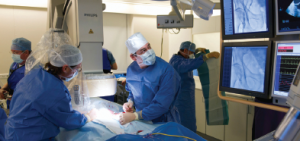News from the world of cardiology

An interventional tool providing greater speed and safety in minimally invasive aortic valve replacements (HeartNavigator, Philips) is now commercially available in Europe. The system is designed to help increase the objectivity of procedure planning
The technology merges preoperatively acquired three-dimensional CT scans with live X-ray views. During the procedure it automatically aligns and overlays these scans onto live X-ray fluoroscopy images, allowing clinicians to see the progress of the guidewire, catheter and valve placement in relation to detailed anatomical structures.
“Through the development of transcatheter valves and sophisticated interventional tools…we are now able to have a major positive impact on people’s quality of life by offering heart valve replacement therapy to a group of patients for whom the risks associated with open heart surgery are too high,” commented Dr JJ Koolen, Head of the Department of Cardiology, Catharina Hospital, Eindhoven, The Netherlands.
“Replacing a valve in a beating heart is a very challenging procedure. By combining detailed 3D CT images with the live 2D X-ray imaging, we get a much better understanding of the patient’s anatomy, helping us to achieve better valve placement and improved clinical outcome,” he added.
